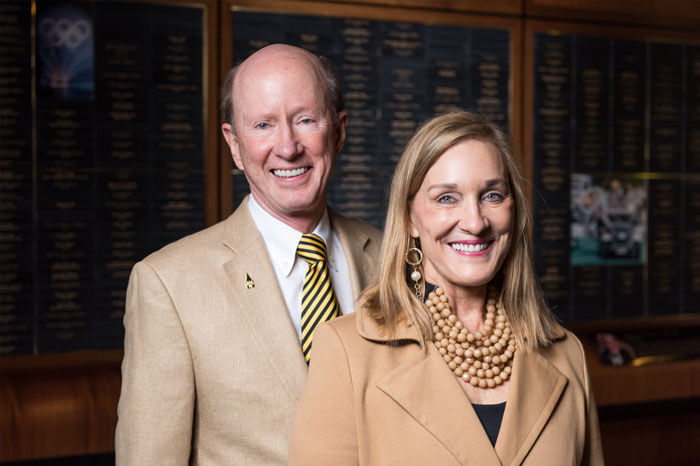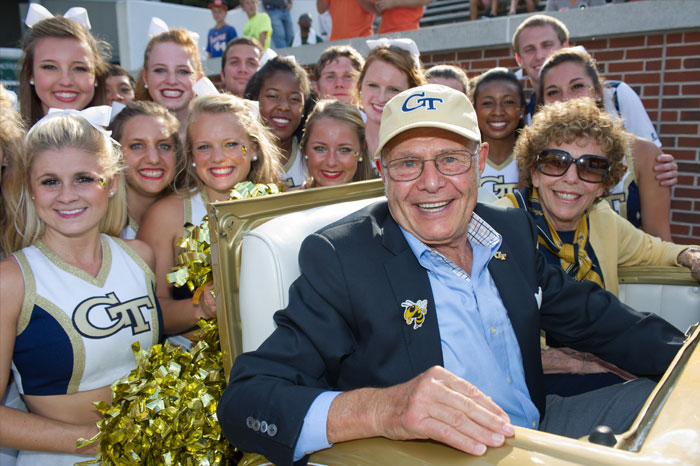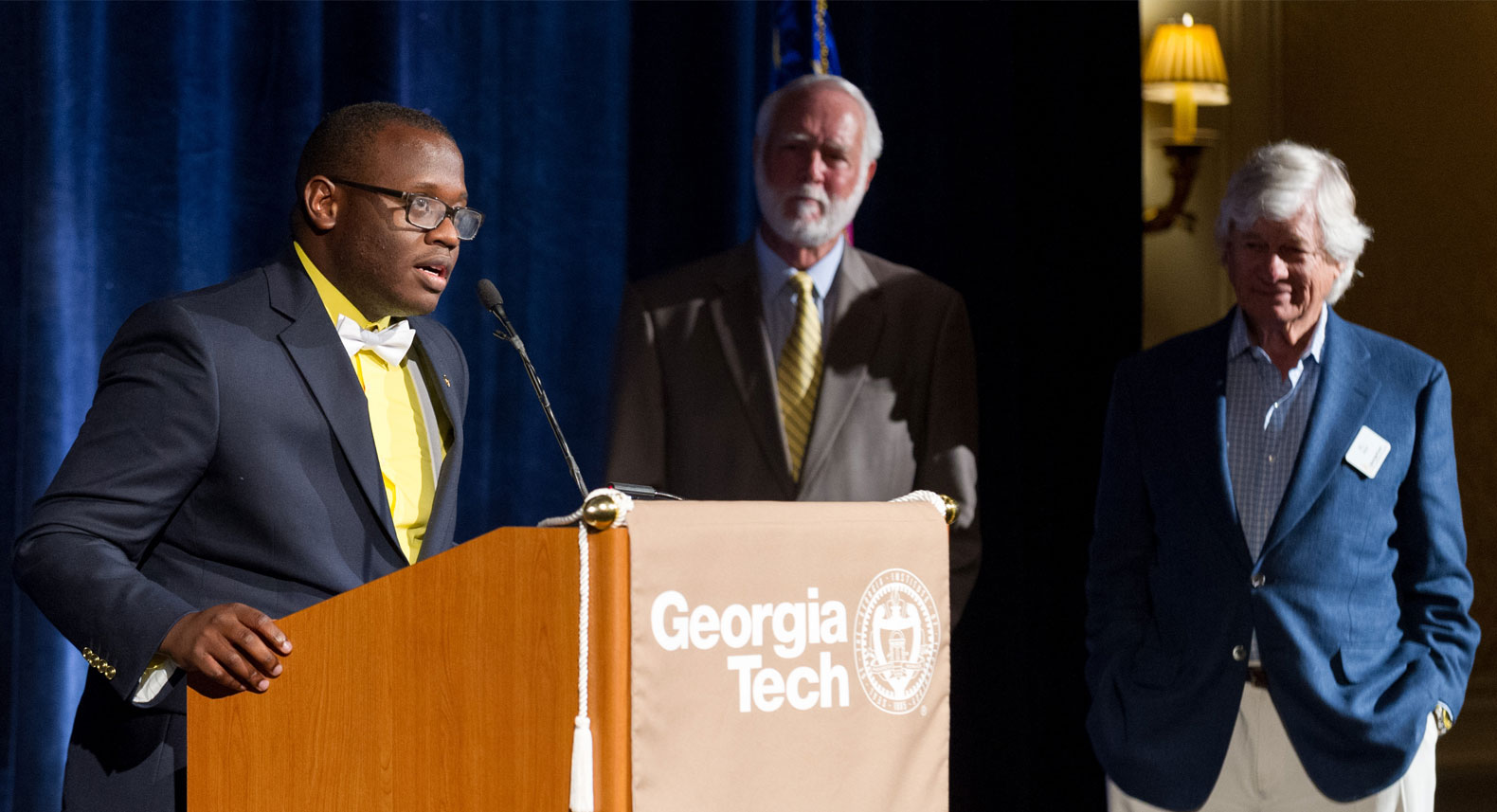
Annual Report Navigation
- Annual Report Home
- Strategic Plan
- Students
- Faculty and Staff
- Research
- Economic Growth
- The World
- Communities
- Philanthropy
Focusing the Power of Philanthropy
The generosity of alumni and other friends plays a pivotal role in Georgia Tech’s ongoing advancement into the ranks of the world’s premier universities.
Campaign Georgia Tech

Campaign Georgia Tech Co-chairs John F. Brock III and Mary Rockett Brock provided inspiring and enthusiastic leadership for Tech's most successful fundraising campaign ever.
The most successful fundraising campaign in Georgia Tech’s history concluded on December 31, 2015. The generosity expressed by more than 90,000 donors has been invested strategically and — in concert with support from the State of Georgia — is working to strengthen and enrich Tech’s student body, faculty, and facilities.
“We are humbled by the knowledge of the impact of Campaign Georgia Tech and what it will do for the Institute, and most importantly for the students and faculty,” said Campaign Co-Chair John F. Brock III, a bachelor’s and master’s alumnus in chemical engineering. “It is an extraordinary success by any measure.”
Not only did the Campaign exceed its $1.5 billion goal by $300 million, but it also succeeded in meeting — and surpassing — every major sub-goal.
“When we launched the public phase of the Campaign in 2010, just coming out of one of the most significant recessions in U.S. history, the Georgia Tech community responded in a way that we could have never imagined,” said President G.P. “Bud” Peterson. “Because of this Campaign, and the support of so many, the future is very exciting. There is no limit to what we can accomplish.”
College/School Namings
Ernest Scheller Jr. College of Business

Ernest Scheller Jr. and his wife, Roberta, made the largest outright gift in Tech's history.
It is a rare event in university business education when a name is added to the ranks of the top public business schools. Joining the iconic brands of Ross, Haas, Darden, Kenan-Flagler, Anderson, Kelley, McCombs, Broad, and Carlson in 2012 was a new player: Scheller.
This seismic shift was the result of the vision and generosity of Roberta and Ernest “Ernie” Scheller Jr., a 1952 industrial management alumnus. Their gift of $50 million established the Ernest Scheller Jr. College of Business among the nation’s most renowned business schools.
Scheller credits his Georgia Tech experience with developing his entrepreneurial edge and laying the foundation he needed for career success. “Georgia Tech taught me to be disciplined and focused in everything I did,” Scheller recalled. “I owe so much to Georgia Tech and the rigorous education I received, and I’ve always felt a tremendous amount of gratitude and a strong desire to give back to the Institute.”
The first half of the $50 million gift was initiated in 2009 in the form of a $20 million Scheller endowment challenge grant and a $5 million expendable dean’s discretionary fund.
H. Milton Stewart School of Industrial and Systems Engineering

The generosity of Milton and Carolyn Stewart has played a leading role in keeping Tech's ISyE school No. 1 nationally for more than two decades.
In 2006, Carolyn and H. Milton Stewart, a 1961 industrial engineering alumnus, made a $20 million commitment naming the H. Milton Stewart School of Industrial and Systems Engineering (ISyE). The commitment established a permanent endowment generating funds available for unrestricted use within the Stewart School.
The Stewarts’ philanthropy made ISyE the fourth named school within the College of Engineering, joining the George W. Woodruff School of Mechanical Engineering, the Daniel Guggenheim School of Aerospace Engineering, and the Wallace H. Coulter Department of Biomedical Engineering.
The Stewart School has been ranked No. 1 in the nation for 25 consecutive years.
“We’re honored to be a part of the ISyE success story that was written by so many alumni and faculty,” the Stewarts said. “Our outstanding faculty, bright students, excellent leadership, and highly supportive alumni give us an important edge in the continuing competition to be the very best.”
Student Support
Stamps President’s Scholars Program/Stamps Leadership Scholars
In 2006, the Stamps Family Charitable Foundation — founded by alumnus E. Roe Stamps IV and his wife, Penny — launched the Stamps Leadership Scholars program inside the President’s Scholarship Program at Georgia Tech to support merit scholarships for the most promising undergraduate scholars from across the nation. Annual gifts provided by the Stamps Foundation are matched by the Institute, and the total funds provide the full cost of attendance and enrichment opportunities over four years for the 10 top freshmen admitted to Georgia Tech annually.

In recognition of Roe and Penny Stamps' increased support of Tech's most prestigious merit scholarship, the program was named the Stamps President's Scholars Program.
Earlier this year, the Stamps Foundation made a commitment to more than double its annual grant to ensure that every President’s Scholar will have the same opportunities provided under the current Stamps Leadership Scholars program.
This means that every student in the President’s Scholars Program — approximately 40 freshmen each year — will receive funding equal to the full cost of attendance for four years (including tuition, fees, books, full room and board, and a stipend for miscellaneous living expenses) plus a laptop and enrichment experiences such as outdoor leadership programs, research and internship opportunities, and at least one international experience, up to $15,000 over four years.
In recognition of this new commitment, the President’s Scholarship Program was renamed the Stamps President’s Scholars Program.
Georgia Tech Promise
In 2007, the Institute launched a scholarship program that was the first of its kind among the state’s public universities — a program that would provide a debt-free Georgia Tech education to students whose only obstacle to success was a lack of financial resources.

Duane Carver, CompE 2010 (left), was the first Tech Promise Scholar to graduate. President Emeritus G. Wayne Clough (center) and former Campaign Georgia Tech Chair Alfred P. West Jr. played pivotal roles in launching the program in 2007.
The G. Wayne Clough Georgia Tech Promise Scholarship program is designed to fill a gap in the financial aid support system, assisting Georgia students whose families have an annual income of less than $33,300.
The program surpassed its $50 million Campaign goal. To date, 473 Tech Promise Scholars from 89 Georgia counties have graduated. Fundraising was accelerated by two separate dollar-for-dollar challenge grants along the way.
Faculty Support
Four Dean’s Chairs, three Engineering School Chairs established
From the beginning of Campaign Georgia Tech, one of the most important priorities was to increase the number of endowed chairs and professorships. With a goal of supporting 100 such positions, the Institute set out to strengthen an already extraordinary faculty by securing the resources that make it possible to recruit and retain the world’s best teacher-scholars and academic leaders.
Four Dean’s Chairs
- Stephen P. Zelnak Jr. Chair, Scheller College of Business
- John Portman Chair, College of Design
- Southern Company Chair, College of Engineering
- Betsy Middleton and John Clark Sutherland Chair, College of Sciences
Three College of Engineering School Chairs
- John F. Brock III School Chair, School of Chemical and Biomolecular Engineering
- Karen and John Huff School Chair, School of Civil and Environmental Engineering
- Anonymous, School of Materials Science and Engineering
Major Facilities Constructed or Renovated

Left, the Engineered Biosystems Building. Right, from top: the Clough Undergraduate Learning Commons, the Brock Football Practice Facility, McCamish Pavilion, and the McAuley Aquatic Center. (EBB photo by Josh Meister.)
- Brock Football Practice Facility
- Byers Tennis Complex
- Caddell Building (Building Construction, College of Design)
- Chandler Stadium (Baseball)
- Clough Undergraduate Learning Commons
- Engineered Biosystems Building
- Marcus Nanotechnology Building
- McAuley Aquatic Center
- McCamish Pavilion (Basketball)
- Noonan Golf Facility
- Zelnak Basketball Center
Annual Report Navigation
(text and background only visible when logged in)
